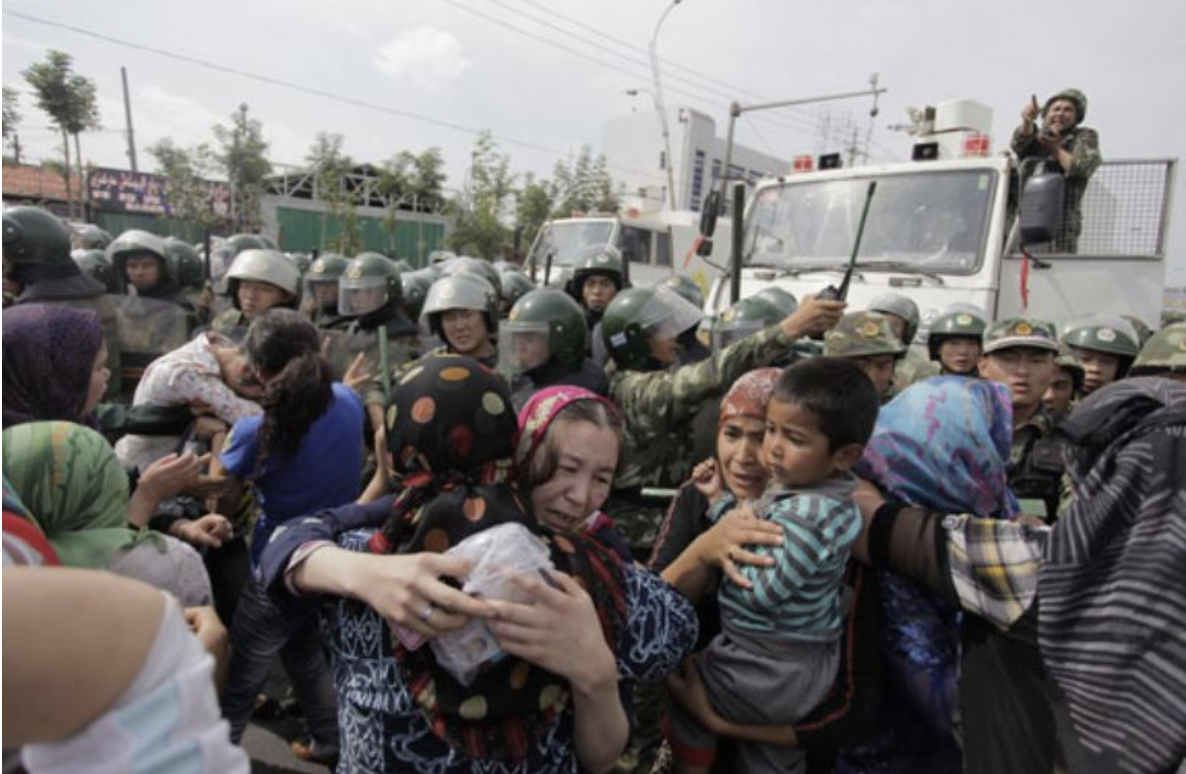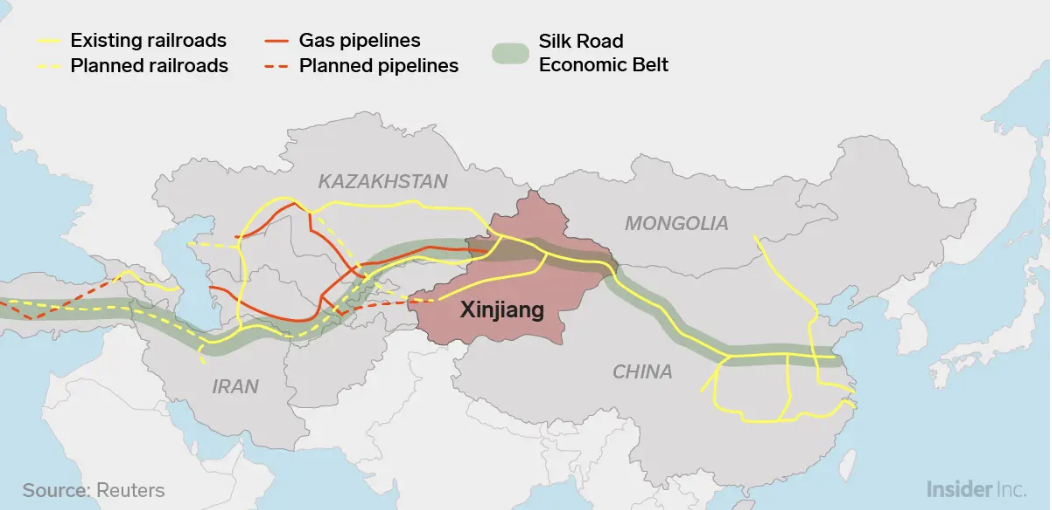
RAINA ZHAO – OCTOBER 22ND, 2019 EDITOR: ALEX CHENG
The situation seems like something out of an Orwellian dystopia. The Xinjiang region of China has been transformed into a modern police state as Xi Jinping’s government significantly increased its security presence in the region. The predominantly Muslim Uighur population has been subject to tactics of repression like an ongoing online surveillance system, bans on religious practices such as veiling faces and keeping long beards, and arrests on nonsensical charges without due process. Organizations like the Human Rights Watch have estimated that up to a million Uighurs are incarcerated in “re-education camps.” While such numbers have not been verified, the slew of firsthand accounts from Uighur survivors are both concerning and damning.
Although tensions between Xinjiang and Beijing have always existed due to tensions between the Uighur and Han ethnic groups, the Chinese government has significantly strengthened its control over Xinjiang in the past few years. President Xi Jinping’s administration has claimed that its actions are in response to the threat of terrorism in the Xinjiang region. The Chinese government has used violent separatist groups like the East Turkestan Islamic Movement to point to a larger problem with terrorism in the region, especially in the wake of events like the 2009 mass riots that broke out in Urumqi, which killed 194 people and injured thousands more. To address these concerns, Beijing has progressively strengthened its security presence over the last decade. In 2010, domestic security spending in Xinjiang increased by 90%.
The situation has only heightened in the past few years, with reports of the mass internment camps coming to light in 2018. The Communist Party’s desire to exact ideological control over the entire nation, like some analysts have suggested, does not fully explain why Beijing has suddenly intensified its efforts in Xinjiang. According to Uighur activist Rushan Abbas, “This has everything to do with the Xi Jinping’s signature project, the Belt and Road Initiative, because the Uighur land is in the heart of the most key point of Xi Jinping’s signature project.”
China’s Belt and Road Initiative (BRI) is an expansive plan that aims to create an open economic zone in Eurasia and the Middle East, echoing the interconnectedness of the historical Silk Road. Xi hopes to build a massive collection of infrastructure projects including railways, energy pipelines, highways, and border crossings to bolster trade between China and its neighbors. Because of the scope of BRI, the project stands to have far-reaching effects not only on the Chinese economy, but also on the Eurasian region as a whole, as it will connect at least 65 countries collectively representing 30% of global nominal GDP.
Xinjiang is a critical location along this new Silk Road. Key routes of the BRI run straight through the region. For example, the China-Pakistan Economic Corridor runs through Xinjiang to link China to the Pakistani port of Gwadar. China Daily, a state-run paper, acknowledges that the region is “a crucial gateway for the Belt and Road Initiative … Its land border with seven countries means it is best placed to expand China’s trade and ties not only with these neighboring nations, but also with Europe and beyond.” The same article notes that almost all trade from Central Asia passes through Xinjiang, and that Beijing hopes to create a transportation and commercial hub there in the future.

Beijing thus has a vested interest in eliminating unrest in Xinjiang. As of May 2019, China has already spent over $200 billion on Belt and Road projects, and the projected gains from the BRI are also significant. A World Bank study found that BRI transportation infrastructure could increase global exports by 6.3%, while partnering states along the economic corridor could see up to a 10% increase in exports.
Considering the amount Beijing has already spent to kickstart the BRI, the Chinese government has strong incentives to secure returns on its investments. Bloomberg noted that “concerns about lawlessness in Xinjiang could chill investment,” both from foreign companies and risk-averse Chinese banks. Any violence in Xinjiang that potentially interferes with the construction of BRI projects is off-putting to financial backers. As an unnamed Chinese financier communicated to a Lowy Institute report, “I prefer to invest in places like Canada and Australia, where I can get safe and decent returns. However, where I have been ordered to invest in [BRI] countries, I will only allocate the minimum amount.” Such fears extend to the unstable Xinjiang. China worries that terrorism in nearby states like Syria and Qatar could aggravate separatist groups in Xinjiang, hindering BRI projects. The government’s actions against the Uighur population could be a preemptive strike to protect its economic investments.
Are the Uighurs simply an obstacle for Beijing’s projects then? Rebecca Warren of RealClearDefense posits that the Belt and Road Initiative projects in Xinjiang actually aim to increase the livelihoods of the Uighurs residing there, with the goal of dissuading extremism and separatist violence. In Xi Jinping’s address to the 19th National Congress of the Communist Party of China in 2017, he vowed to “devote more energy to speeding up the development of old revolutionary base areas, areas with large ethnic minority populations, border areas, and poor areas.” The Belt and Road Initiative could be a means to actualize that priority. Peter Cai from the Lowy Institute argues that “the regional development aspect of [the Belt and Road Initiative] is perhaps one of China’s most important economic policy objectives.” If successful, Xi’s administration believes it can quell the dissatisfaction that spurred the 2009 riots and avoid similar events. As Lu Shuling, the former Chinese ambassador to Islamabad, stated, “The best medicine to address the terrorism problem is through tackling the incubator of terrorism, namely poverty.”
If Beijing intends to improve the Uighurs’ livelihood through the BRI, the initiative may generate the same concerns as past development projects. In 1999, the Chinese government launched an initiative called the Great Leap West to modernize and enrich Xinjiang in order to better integrate the Uighurs into Chinese society. The Great Leap West introduced a slew of infrastructure projects and investments into Xinjiang, with the central government spending around one hundred billion renminbi in just the first year. On paper, the policy was a success. Xinjiang’s GDP has skyrocketed since 2000 and aggregate wages have increased by 470%.
If the BRI were simply a continuation of past economic policies regarding Xinjiang, why the sudden crackdown in the past few years? The twisted irony of repressing the Uighurs for the purpose of helping them cannot be rationalized, though a closer examination of Great Leap West policies may reveal an explanation. Xinjiang’s past economic growth does not apply equally to the Uighur and Han populations. As Xinjiang modernized, an influx of Han workers migrated to the region in search of the increasing job opportunities. While Hans were only 7% of the Xinjiang population in 1949, that number increased to over 40% by 2010. This migration of Hans explains a significant portion of Xinjiang’s recorded economic growth. The average income for a Han was 1,141 RMB (161.24 USD as of 10/21/2019) per month in 2011, while the average Uighur earned 892 RMB per month. Unsurprisingly, ethnic profiling has been observed in hiring practices.
Xinjiang’s development also involves extraction of its natural resources. When such resources are extracted, however, the Uighurs receive almost no benefits from their region’s own wealth. Xinjiang’s reserves of natural gas, coal, and other fossil resources represent over 20% of China’s total energy reserves, making it the largest fossil fuel source in the country. China’s coal consumption has risen significantly in the past two decades and it has been a net importer of coal since 2009 to satisfy this high demand. Access to Xinjiang’s energy resources are vital to China’s rapid industrialization, but means that only 2% of Xinjiang’s oil remains in the region. The rest services the wealthy Han-dominated urban centers on the east coast via the Xinjiang-Shanghai pipeline.
The logic of a short-term crackdown on Uighur rights with the long-term goal of economic development to prevent terrorism is paradoxical. As Weiwen Yin of Texas A&M University found, the increase in economic performance from the Great Leap West had a positive correlation with the probability of terrorist attacks—precisely because unequal economic gains across ethnic lines spawned grievances among the Uighur population. Beijing’s current tactics of repression are likely to generate even more discontent among the Uighurs. The approach is counterproductive if the Chinese government’s goal is truly to foster regional development as an anti-extremism measure. The more pernicious possibility is that the BRI, and all the limits on Uighur freedoms accompanying it, was always designed to serve the Han majority. Either possibility comes at a significant human cost that the international community cannot ignore.
Featured Image Source: Jacobin
Secondary Image Source: Business Insider
Disclaimer: The views published in this journal are those of the individual authors or speakers and do not necessarily reflect the position or policy of Berkeley Economic Review staff, the Undergraduate Economics Association, the UC Berkeley Economics Department and faculty, or the University of California, Berkeley in general.



